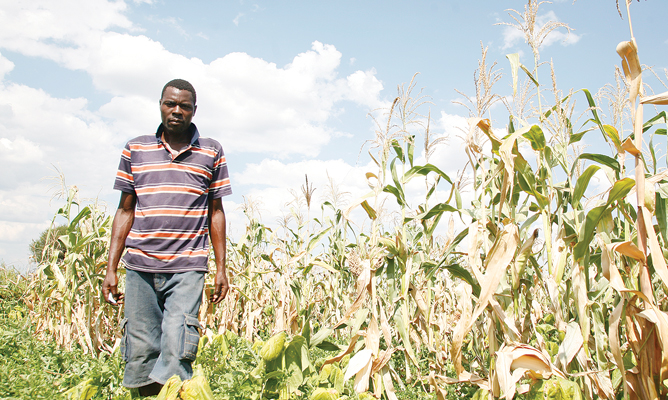
Climatologists have predicted the 2015-16 El Ninõ weather phenomenon will become one of the most severe on record — something that many in Zimbabwe would readily agree with.
BY CHIPO MASARA
Add global warming and climate change to the mix and the results have been catastrophic. For the country’s agricultural sector, the impact has been most devastating.
Experts have for years been warning about how climate change was expected to amplify the stress on water availability and as a result, drastically reduce crop productivity, with yields set to continually drop.
In Zimbabwe’s case, the warnings have proved warranted as the past decade has seen a clear shift in the weather patterns — characterised by extremely hot weather conditions, late onset of the rainy season and when it finally comes, erratic rainfall patterns punctuated by long dry spells — among other extreme climatic changes.
When I talked to John Mapuro, principal meteorological officer at the Meteorological Services Department two years ago, he mentioned how the country had for years been experiencing a reduction in mean rainfall days, characterised by very heavy down pours that are followed up by long dry spells. Owing to the El Ninõ-induced drought that is currently ravaging the country — as it is most parts of the world — the climate change results are being felt worse than before.
The El Ninõ phenomenon and climate change have brought untold hunger to the country as small scale and subsistence farming has, to a larger extent, been rendered a waste of time and inputs as the farmers will reap very little — if anything — from their efforts as most of the crops have been declared a write off.
So dire is the food insecurity — which has been blamed on the drought — that the government has since declared it a national disaster. As things stand, it still remains unclear how the government plans to feed the millions of people that are in desperate need of food assistance.
- Chamisa under fire over US$120K donation
- Mavhunga puts DeMbare into Chibuku quarterfinals
- Pension funds bet on Cabora Bassa oilfields
- Councils defy govt fire tender directive
Keep Reading
But then, would the food insecurity situation have gotten so dire had the government heeded the early warning signs that have for long called for the building of climate change adaptation capacities?
But in typical Zimbabwe government fashion, it had to take the situation reaching unprecedented levels for it to raise alarm. Unfortunately, it would seem all efforts are now being exhausted on sourcing grain for the hungry millions, with none going towards ensuring that the country does not undergo the same experience next year.
While one would not expect the authorities to stop the El Ninõ phenomenon, or climate change — as it is far beyond them — there is a lot that can be done to help farmers cope with the dry spells on a permanently sustained basis.
There is absolute need, for example, to invest heavily in small-scale irrigation systems in the form of small farm reservoirs, small diversion dams, shallow tube wells and pump irrigation systems, among other ways to ensure no amount of rainfall is put to waste. Zimbabwe’s farmers would do well to take a leaf from the late Zepheniah Phiri Maseko — Zimbabwe’s celebrated conservationist and water harvester who passed away last year. Phiri practised sustainable conservation methods that ensured that no vital resource was lost, in the process improving soil quality and preventing water run-off. There is also need to increase farmers’ access to reliable and timely scientific weather forecasts so that their ability to deal with El Ninõ and climate change-related weather events is enhanced.
As things stand, it is increasingly becoming difficult for farmers to continue following their usual farming calendars as the rainfall patterns have become very unpredictable.
Those that have stuck to traditional planting times have learnt about climate change the hard way.
General broad weather forecasts are no longer good enough. In order to be effective, they should be timely, more detailed and site-specific.
For instance, the country is effectively divided into five climatic regions, with the severity of the drought differing in each region.
In fact, experts say the consequences of a drought could vary within the same individual farm or plot of land, with the fields on the highest part of the topographic sequence likely to suffer water stress earlier than the fields at the bottom. So to dish out general weather forecasts to farmers that are affected differently, is a serious disservice.
Zimbabwean farmers would also do well to adopt conservation farming, which entails zero tillage, contour farming, alley cropping, crop rotation and trap cropping, among other farming methods that have been proven to prevent the high rate of soil erosion and water runoff, as well as improving the soil’s fertility.
While El Ninõ has worsened things; the truth is that even in its absence, the country would still have needed to deal with the long-term effects of climate change.
It is time to once and for all put in place measures that tackle the problem in a sustainable way in order to improve the country’s agricultural sector and stop people from starving, among all else. l For feedback, email on [email protected]











